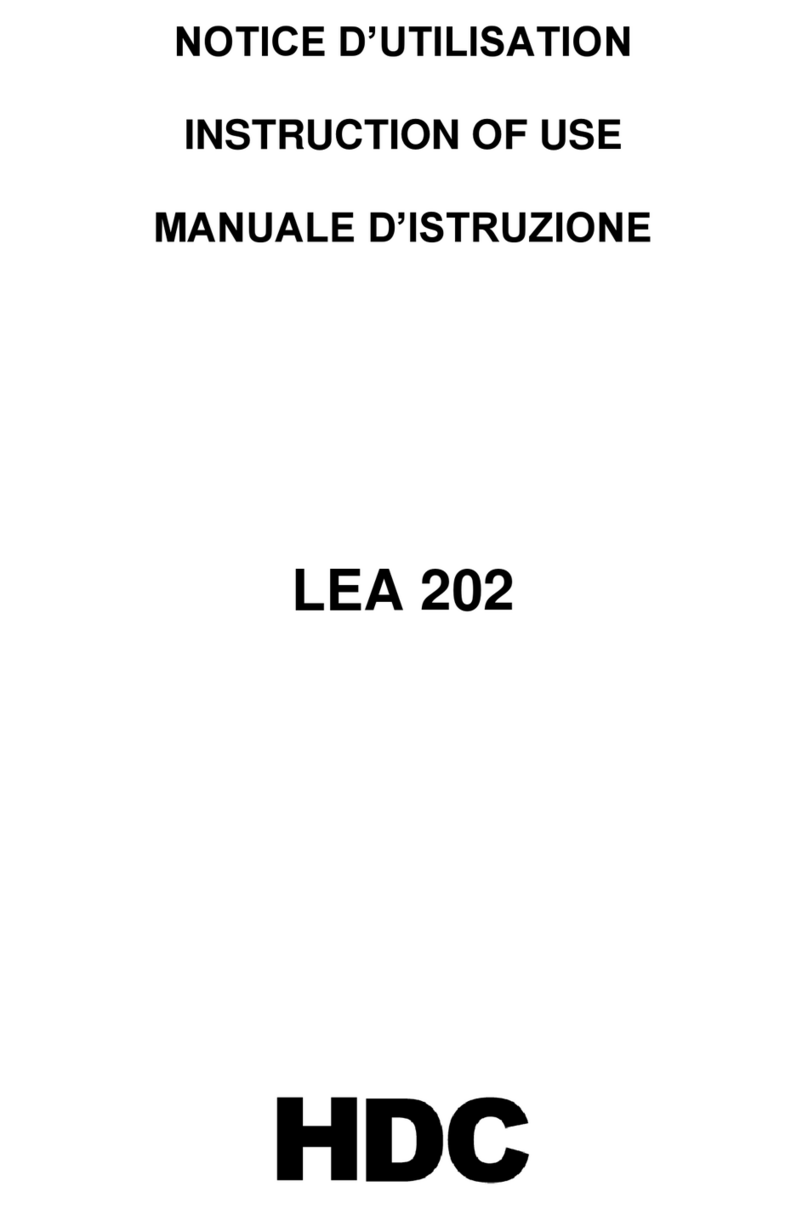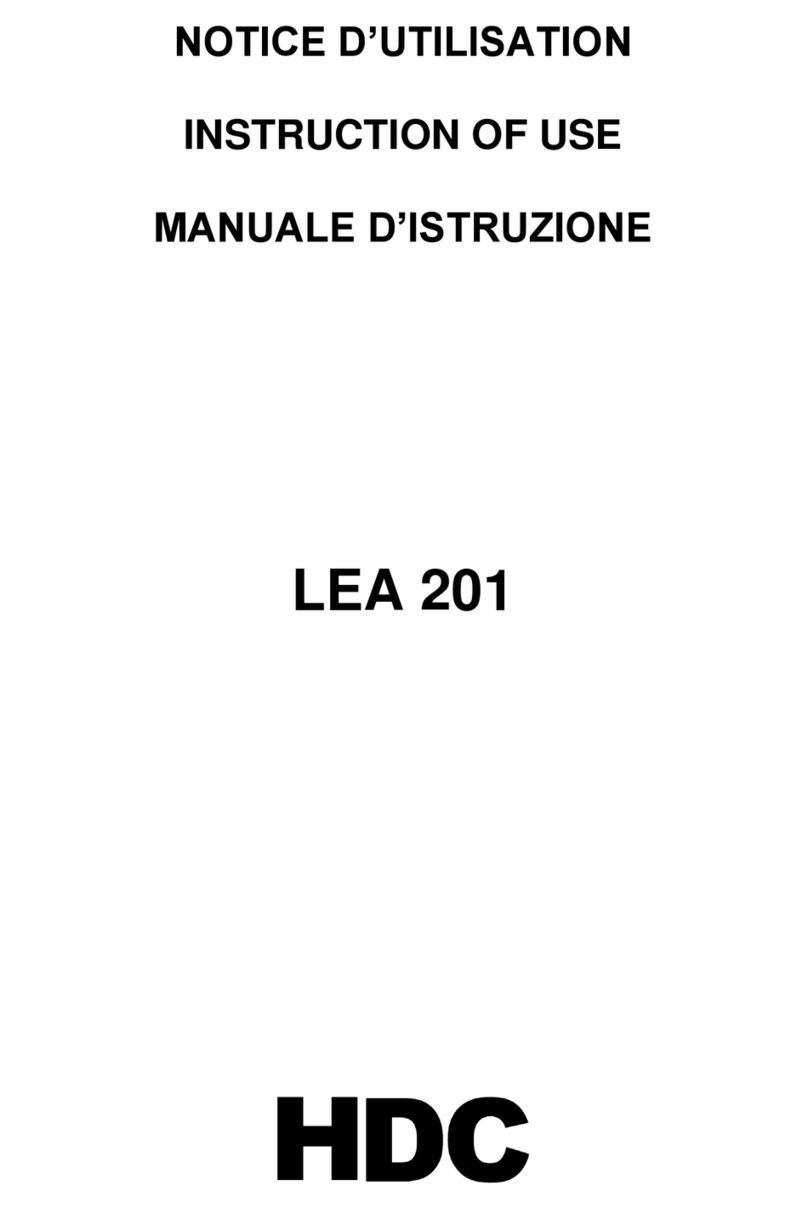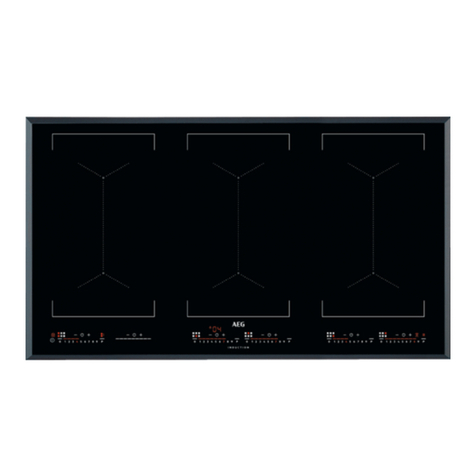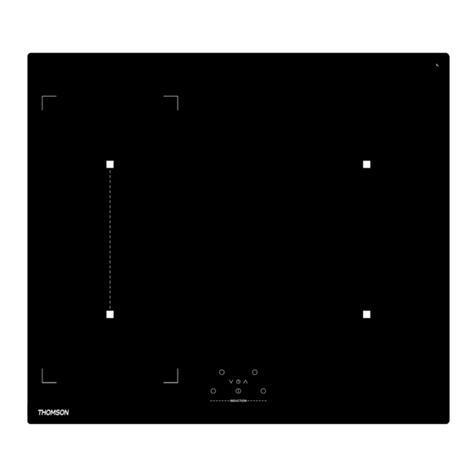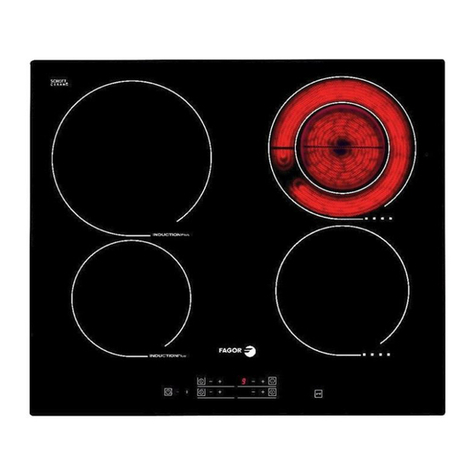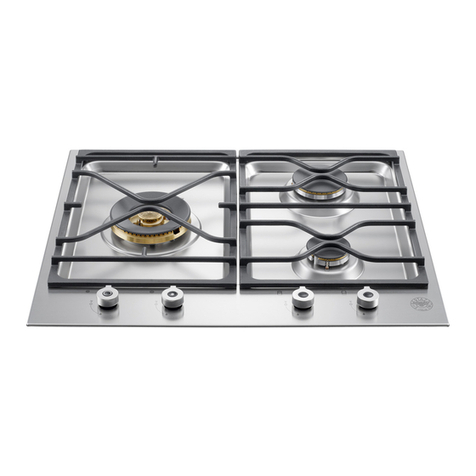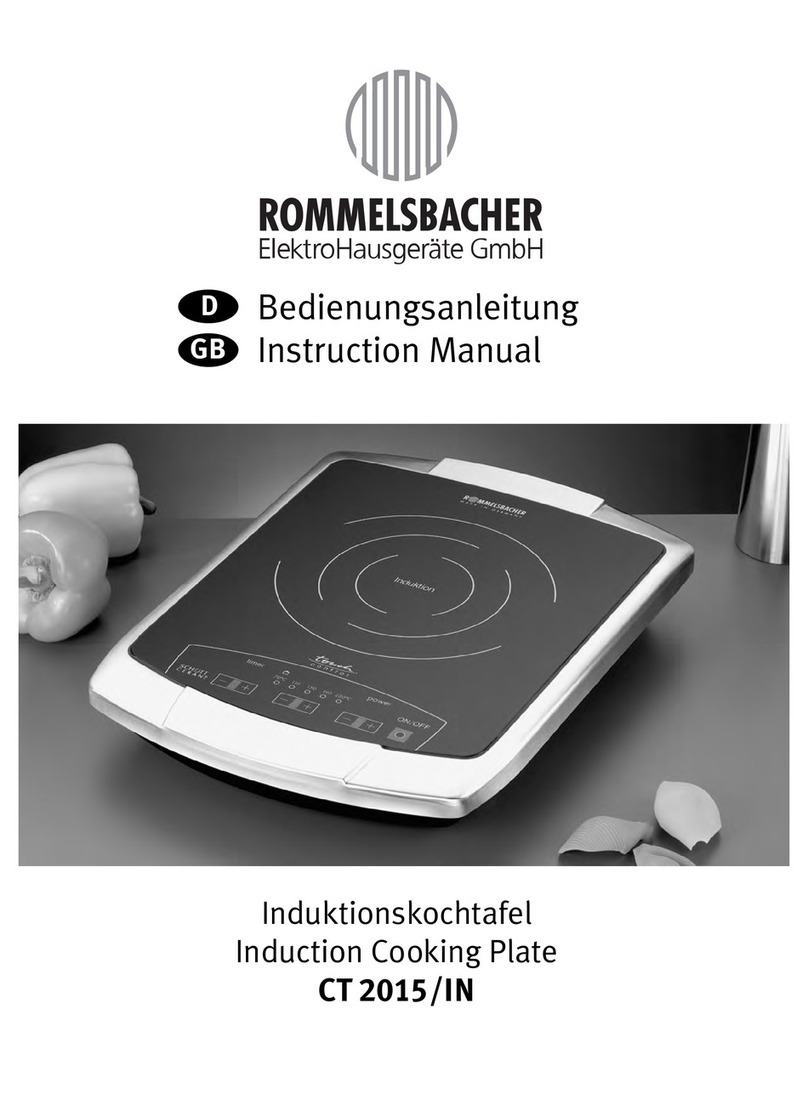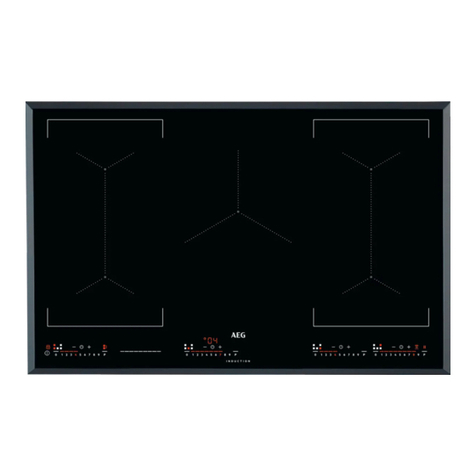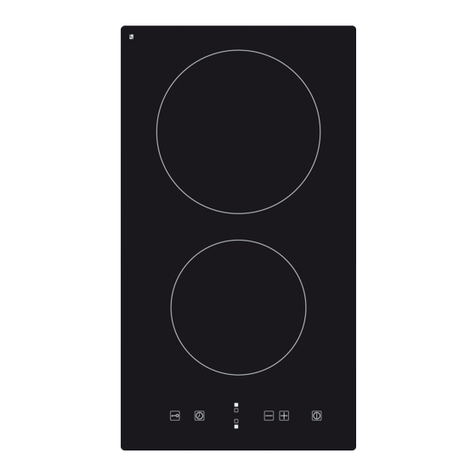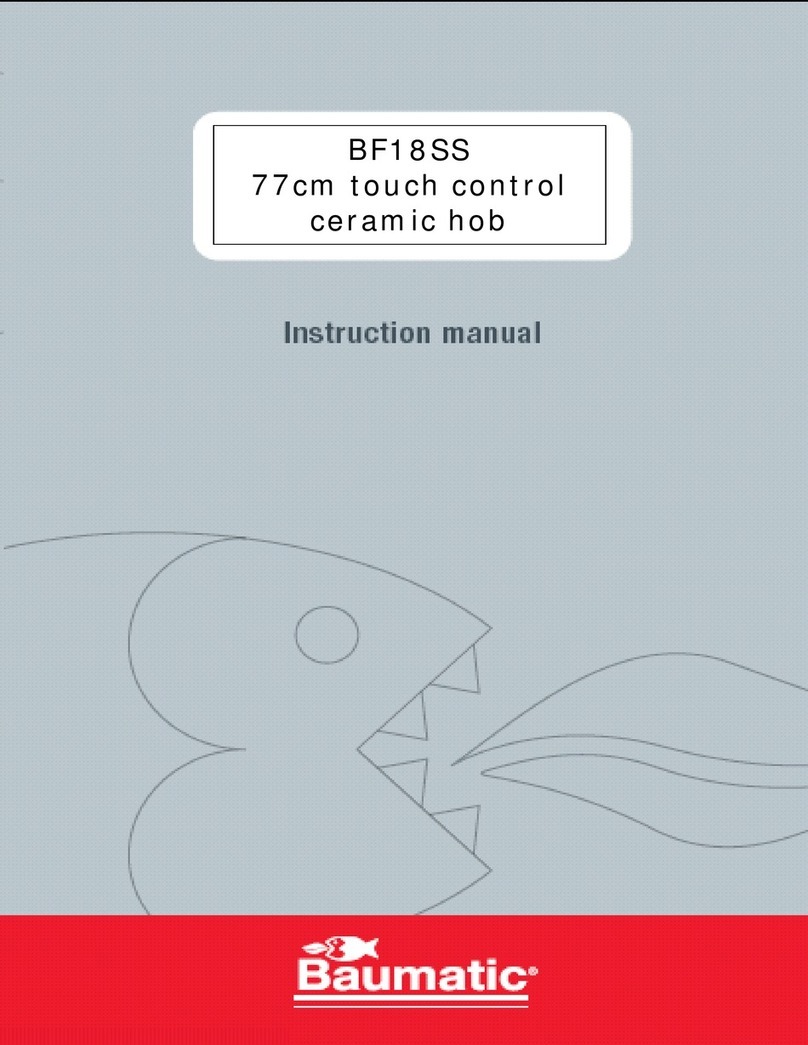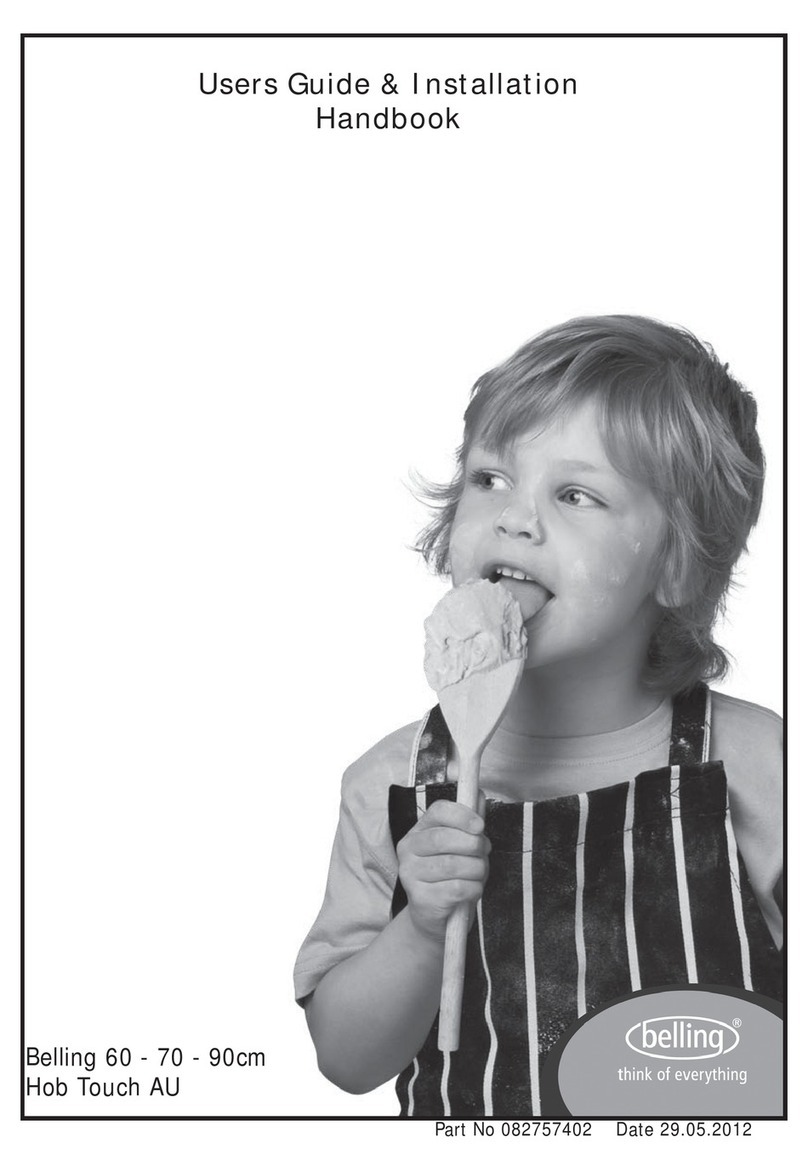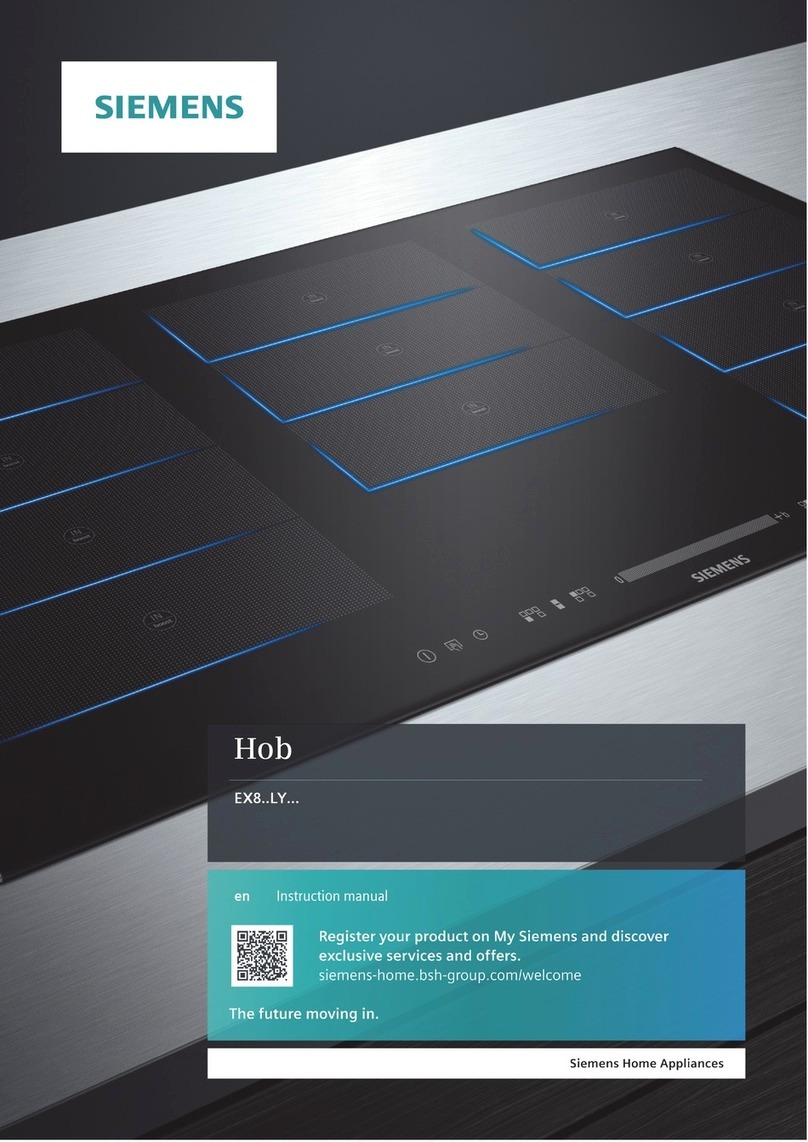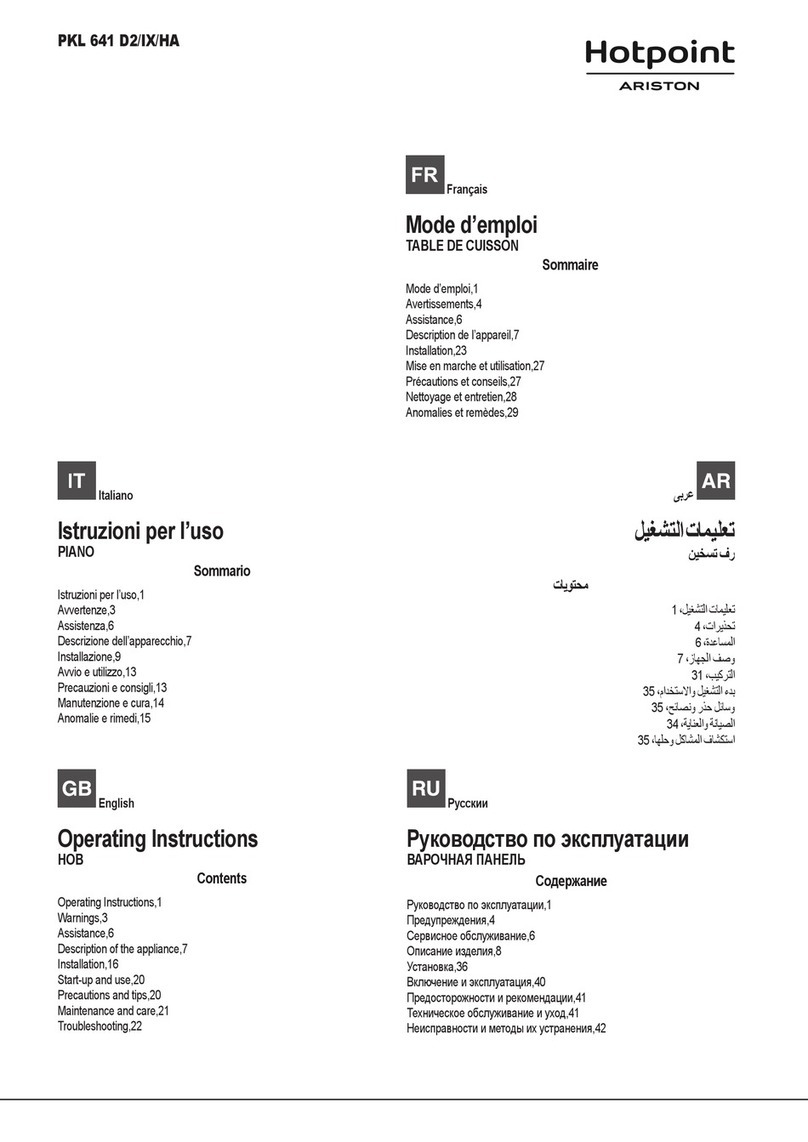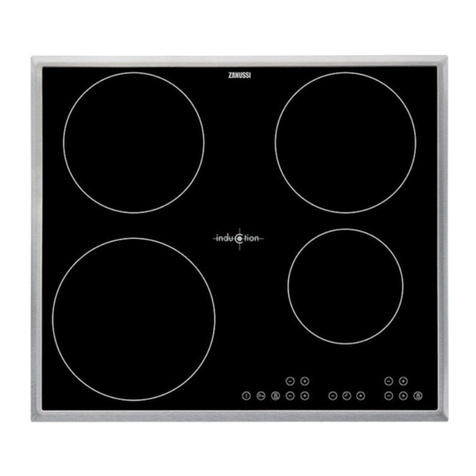HDC LEA 351 Instruction Manual

NOTICE D’UTILISATION
INSTRUCTION OF USE
MANUALE D’ISTRUZIONE
LEA 351

2

3
Chère cliente, cher client,
Nous vous remercions de la confiance que vous nous avez accordée en choisissant notre table
de cuisson vitrocéramique.
Afin de bien connaître cet appareil,nous vous recommandons de lire attentivement cette notice
d’utilisation dans son intégralité et de la conserver pour une consultation ultérieure.
SOMMAIRE
SECURITE...................................................................................................................................4
PRECAUTIONS AVANT UTILISATION EN CUISSON.............................................................................4
UTILISATION DE L’APPAREIL.........................................................................................................4
PRECAUTIONS POUR NE PAS DETERIORER L’APPAREIL ...................................................................5
PRECAUTIONS EN CAS DE DEFAILLANCE DE L’APPAREIL..................................................................5
AUTRES PROTECTIONS ...............................................................................................................5
DESCRIPTION DE L’APPAREIL ................................................................................................6
CARACTERISTIQUES TECHNIQUES ................................................................................................6
BANDEAU DE COMMANDE ............................................................................................................6
UTILISATION DE L’APPAREIL ..................................................................................................6
TOUCHES SENSITIVES.................................................................................................................6
AFFICHAGE................................................................................................................................6
MISE EN ROUTE ET GESTION DE L’APPAREIL......................................................................7
AVANT LA PREMIERE UTILISATION.................................................................................................7
MISE EN ROUTE..........................................................................................................................7
INDICATEUR DE CHALEUR RESIDUELLE..........................................................................................7
DOUBLE ZONE CONCENTRIQUE ....................................................................................................7
VERROUILLAGE DU BANDEAU DE COMMANDE.................................................................................8
CONSEILS DE CUISSON ...........................................................................................................8
EXEMPLES DE REGLAGE DES PUISSANCES DE CUISSON..................................................................8
ENTRETIEN ET NETTOYAGE....................................................................................................9
QUE FAIRE EN CAS DE PROBLEME........................................................................................9
PROTECTION DE L’ENVIRONNEMENT....................................................................................9
INSTRUCTIONS D’INSTALLATION .........................................................................................10
CONNEXION ELECTRIQUE .....................................................................................................11

4
SECURITE
Précautions avant utilisation en cuisson
Retirez toutes les parties de l’emballage.
L’installation et le branchement électrique de l’appareil sont à confier à des spécialistes
agrées. Le fabricant ne saurait être tenu responsable des dommages résultant d’une
erreur d’encastrement ou de raccordement.
L’appareil ne doit être utilisé que s’il est monté et installé dans un meuble et un plan de
travail homologué et adapté.
Son utilisation est uniquement destinée à l’usage domestique habituel (préparation des
aliments), à l’exclusion de toute autre utilisation domestique, commerciale ou industrielle.
Enlevez toutes les étiquettes et autocollants du verre vitrocéramique.
Ne pas transformer ou modifier l’appareil.
La table de cuisson ne doit pas servir de support ou de plan de travail.
La sécurité n’est assurée que si l’appareil est raccordé à une terre de protection
conforme aux prescriptions en vigueur.
Pour le raccordement au réseau électrique n’utilisez pas de rallonge.
L’appareil ne doit pas être utilisé au-dessus d’un lave-vaisselle ou d’un sèche-linge : les
vapeurs d’eau dégagées pourraient détériorer l’électronique.
Utilisation de l’appareil
Coupez toujours les foyers après utilisation.
Surveillez constamment les cuissons qui utilisent des graisses et des huiles, car elles
sont susceptibles de s’enflammer rapidement.
Prenez garde aux risques de brûlures pendant et après l’utilisation de l’appareil.
Assurez-vous qu’aucun câble électrique d’appareil fixe ou mobile ne vienne en contact
avec la vitre ou la casserole chaude.
Les objets magnétisables (cartes de crédits, disquettes informatiques, calculatrices) ne
doivent pas se trouver à proximité immédiate de l’appareil en fonction.
Ne placez aucun objet métallique autre que les récipients de chauffe. En cas
d’enclenchement intempestif ou de chaleur résiduelle, celui-ci risquerait selon le
matériau de chauffer, de fondre ou de commencer à brûler.
Ne jamais couvrir l’appareil d’un chiffon ou d’une feuille de protection. Il pourrait devenir
très chaud et prendre feu.
Cet appareil n'est pas destiné à être utilisé par des personnes (enfants y compris) ayant
des facultés physiques, sensorielles ou mentales réduites, ou un manque d'expérience et
de connaissance, à moins qu'elles aient eu des explications concernant l'utilisation de
l'appareil par une personne chargée de leur sécurité.
Les enfants doivent être informés pour s'assurer qu'ils ne jouent pas avec l'appareil.
Les objets métalliques tels que des couteaux, des fourchettes, des cuillères et des
couvercles ne devraient pas être placés la surface vitrée puisqu'ils peuvent devenir
chauds.

5
Précautions pour ne pas détériorer l’appareil
Les casseroles à semelles brutes (fonte non émaillée,…) ou abîmées peuvent
endommager la vitrocéramique.
La présence de sable ou d’autres matériaux abrasifs peut endommager la
vitrocéramique.
Evitez de faire chuter des objets, mêmes petits, sur la vitrocéramique.
Ne heurtez pas les bords de la vitre avec les casseroles.
S’assurer que la ventilation de l’appareil se fasse suivant les instructions du constructeur.
Ne posez pas ou ne pas laisser de casseroles vides sur la table de cuisson.
Eviter que le sucre, les matières synthétiques ou une feuille d’aluminium ne touchent les
zones chaudes. Ces substances peuvent au refroidissement provoquer des cassures ou
d’autres modifications de la surface vitrocéramique: Etendre l’appareil et enlevez-les
immédiatement de la zone de cuisson encore chaude (attention : risque de brûlures).
Ne placez jamais de récipients chauds au dessus de la zone de commande.
Si un tiroir est situé sous l’appareil encastré, assurer un écart suffisant (2 cm) entre le
contenu de ce tiroir et la partie inférieure de l’appareil afin d’assurer une bonne
ventilation.
Ne déposez pas d’objets inflammables (ex. sprays) dans le tiroir placé sous la table de
cuisson. Les éventuels casiers à couverts doivent être en matériau résistant à la chaleur.
Précautions en cas de défaillance de l’appareil
Si un défaut est constaté, il faut déclencher l’appareil et couper la ligne d’alimentation
électrique.
En cas de fêlure ou de fissure de la vitrocéramique il faut impérativement débrancher
l’appareil du réseau électrique et prévenir le service après-vente.
Les réparations doivent être entreprises exclusivement par un personnel spécialisé.
N’ouvrez en aucun cas l’appareil vous-même.
ATTENTION : Si la surface vitrée est fissurée, coupez l’alimentation de l’appareil pour
éviter une éventuelle décharge électrique.
Autres protections
Assurez-vous que le récipient de cuisson soit toujours centré sur la zone de cuisson. Le
fond de la casserole doit autant que possible couvrir la zone de cuisson.
Pour les utilisateurs portant un régulateur de rythme cardiaque, le champ magnétique
pourrait influencer son fonctionnement. Nous recommandons de se renseigner auprès
du revendeur ou du médecin.
N’utilisez pas de récipients en matière synthétique ou en aluminium : ils pourraient
fondre sur des foyers encore chauds.

6
DESCRIPTION DE L’APPAREIL
Caractéristiques techniques
Type Puissance totale Position du foyer Puissance Nominale
Diamètre
LEA 351 5400W Avant gauche
Arrière gauche
Droit
1800 W
1200 W
2400/1500 W
190 mm
155 mm
280/215 mm
Bandeau de commande
UTILISATION DE L’APPAREIL
Touches sensitives
Votre appareil est équipé de touches sensitives permettant de commander les différentes
fonctions. Un effleurage de la touche active leur fonctionnement. Cette activation est validée par
un voyant, un affichage et/ou par un signal sonore.
N’appuyez que sur une seule touche à la fois.
Affichage
Affichage Désignation Fonction
0 Zéro La zone de chauffe est activée
1…9 Niveau de puissance Choix du niveau de cuisson
E Message d’erreur Défaut de circuit électronique
H Chaleur résiduelle La zone de cuisson est chaude
L Verrouillage La table est sécurisée
Touche [ - ]
Touche [ + ]
Touche
Marche/Arrêt
Afficheur
Touche double
zone

7
MISE EN ROUTE ET GESTION DE L’APPAREIL
Avant la première utilisation
Nettoyez votre appareil avec un chiffon humide, puis séchez-le. N’utilisez pas de détergent qui
risquerait de provoquer une coloration bleutée sur les surfaces vitrées.
Mise en route
Vous devez d’abord enclencher la table de cuisson, puis la zone de chauffe :
Enclencher / arrêter la table de cuisson :
Action Bandeau de commande Afficheur
Enclencher appuyer sur [ ] 3 x [ 0 ]
Arrêter appuyer sur [ ] aucun ou [ H ]
Enclencher / arrêter une zone de chauffe :
Action Bandeau de commande Afficheur
Sélectionner la zone appuyer sur [ + ] afficheur allumé
Augmenter appuyer sur [ + ] [ 1 ] jusqu’à [ 9 ]
Diminuer appuyer sur [ -] [ 9 ] jusqu’à [ 1 ]
Arrêter appuyer simultanément sur [ + ] et [ -] [ 0 ] ou [ H ]
ou appuyer sur [ -] [ 0 ] ou [ H ]
Si aucun réglage n’est fait dans un délai de 20 secondes l’électronique revienten position
d’attente.
Indicateur de chaleur résiduelle
Après l’arrêt des zones de cuisson ou l’arrêt complet de la table, les zones de cuissons sont
encore chaudes et sont signalées par le symbole [ H ]
Le symbole [ H ] s’éteint lorsque les zones de cuisson peuvent être touchées sans danger.
Tant que les témoins de chaleur résiduelle sont allumés, ne touchez pas les zones de cuisson
et ne posez aucun objet sensible à la chaleur. Risque de brûlure et d’incendie !
Double zone concentrique
La zone droite est extensible afin de mieux adapter la surface de cuisson au fond de la
casserole.
Diminution et extension de zone :
Action Bandeau de commande Afficheur
Sélectionner la zone Appuyer sur [ + ] [ 0 ]
Diminuer la surface Appuyer sur [ ] Voyant éteint
Augmenter le diamètre Appuyer sur [ ] Voyant allumé

8
Verrouillage du bandeau de commande
Pour éviter de modifier une sélection de le table de cuisson, notamment dans le cadre du
nettoyage de la vitre, le bandeau de commande (a l’exception de la touche marche/arrêt [ ])
peut être verrouille.
Verrouillage :
Action Bandeau de commande Afficheur
Enclencher appuyer sur [ ] 3 x [ 0 ] ou [ H ]
Verrouiller la table appuyer ensemble [ -] et [ + ]
de la zone arrière gauche pas de changement
Ré appuyer sur [ + ] 3 x [ L ]
Déverrouillage :
Action Bandeau de commande Afficheur
Enclencher appuyer sur [ ] 3 x [ L ]
Dans les 5 secondes après la mise en route :
Déverrouiller la table appuyer ensemble [ -] et [ + ]
de la zone arrière gauche 3 x [ 0 ]
Ré appuyer sur [ -] les afficheurs
sont éteints
CONSEILS DE CUISSON
Exemples de réglage des puissances de cuisson
(Les valeurs ci-dessous sont indicatives)
1 à 2 Faire fondre
Réchauffer Sauces, beurre, chocolat, gélatine
Plats pré-cuisinés
2 à 3 Gonfler
Décongélation Riz, pudding et plats cuisinés
Légumes, poisson, produits congelés
3 à 4 Vapeur Légumes, poissons, viande
4 à 5 Eau Pommes de terre à l’eau, soupes, pâtes
Légumes frais
6 à 7 Cuire à feu doux Viandes, foie, œufs, saucisses
Goulasch, roulades, tripes
7 à 8 Cuire, Frire Pommes de terre, beignets, galettes
9 Frire,
Porter à ébullition Steaks, omelettes
eau

9
ENTRETIEN ET NETTOYAGE
Pour nettoyer il faut mettre l’appareil hors fonctionnement.
Laissez refroidir l’appareil, car risques de brûlures.
Nettoyez les restes de cuisson avec de l’eau additionnée de produit vaisselle ou un
produit du commerce conseillé pour la vitrocéramique.
N’utilisez en aucun cas d’appareils « à vapeur » ou « à pression ».
Ne pas utiliser d’objets qui risqueraient de rayer la vitrocéramique (tel que tampon
abrasifs ou pointe de couteau…).
N’utilisez pas de produits de nettoyage abrasifs qui pourraient endommager l’appareil.
Séchez l’appareil avec un chiffon propre.
Enlevez immédiatement le sucre et les mets contenant du sucre.
QUE FAIRE EN CAS DE PROBLEME
La table de cuisson ou les zones de cuisson ne s’enclenchent pas :
la table est mal connectée au réseau électrique
le fusible de protection a sauté
les touches sensitives sont couvertes d’eau ou de graisse
un objet est posé sur les touches sensitives
Le symbole [ E ] s’affiche :
appelez le Service Après-ventes
L’une des zones ou l’ensemble du plan de cuisson se déclenche :
le déclenchement de sécurité a fonctionné
celui-ci s’actionne dans le cas ou vous avez oublié de couper une des zones de chauffe
il s’enclenche également lorsqu’une ou plusieurs touches sensitives sont couvertes
Le symbole [ L ] s’affiche :
se référer au chapitre verrouillage du bandeau de commande
PROTECTION DE L’ENVIRONNEMENT
les matériaux d’emballage sont écologiques et recyclables
les appareils électroniques sont composés de matériaux recyclables et parfois de
matériaux nocifs pour l’environnement, mais nécessaires au bon fonctionnement et à la
sécurité de l’appareil
ne jetez en aucun cas votre appareil avec les déchets
ménagers
faites appel au service d’enlèvement ou aux sites de
dépôt mis en place par votre commune et adaptés au
recyclage des appareils électroménagers

10
INSTRUCTIONS D’INSTALLATION
Le montage relève de la compétence exclusive de spécialistes.
L’utilisateur est tenu de respecter la législation et les normes en vigueur dans son pays de
résidence.
Mise en place du joint d’étanchéité
Le joint adhésif fourni avec l’appareil permet d’éviter toute infiltration dans le meuble.
Sa mise en place doit être effectuée avec un grand soin suivant le croquis ci-dessous.
Encastrement :
Découpe du plan de travail :
Appareil Dimension de découpe
LEA 351 490 x 560 mm
La distance entre la table de cuisson et le mur doit être au minimum de 50mm.
La table de cuisson est un appareil qui appartient à la classe de protection « Y ». Lors de
son encastrement, une paroi d’armoire haute ou un mur peut se trouver sur l’un des
côtés et sur la face arrière. Mais de l’autre côté, aucun meuble ni aucun appareil ne
doit être plus haut que le plan de cuisson.
Les placages et revêtements des plans de travail doivent être réalisés en matériaux
résistant à la chaleur (100°C)
Les baguettes de bord murales doivent être thermo résistantes
Les matériaux des plans de travail peuvent gonfler au contact de l’humidité. Pour
protéger le chant de la découpe, appliquer un vernis ou une colle spéciale.
N’installer pas la table au dessus d’un four non ventilé ou d’un lave-vaisselle
Garantir entre le fond du caisson de l’appareil un espace de 20 mm pour assurer une
bonne circulation de l’air de refroidissement de l’électronique
Si un tiroir se trouve sous le plan de cuisson, éviter d’y ranger des objets inflammables
(par exemple : spray) et des objets non résistants à la chaleur
L’écart de sécurité entre la table de cuisson et la hotte aspirante placée au-dessus d’elle
doit respecter les indications du fabricant de hottes. En cas d’absence d’instructions
respecter une distance minimum de 760mm
Le câble de raccordement ne doit être soumis, après encastrement, à aucune contrainte
mécanique, comme par exemple du fait d’un tiroir.
Coller le joint (2) sur le rebord de la
table à 2mm du bord externe, après
avoir ôté la feuille de protection (3).

11
CONNEXION ELECTRIQUE
L’installation de cet appareil et son branchement au réseau électrique ne doit être
confiés qu’à un électricien parfaitement au fait des prescriptions normatives.
La protection contre les pièces sous tension doit être assurée après le montage.
Les données de raccordement nécessaires se trouvent sur la plaque signalétique et la
plaque de branchement placées sous l’appareil.
Cet appareil doit être séparé du secteur par un dispositif de sectionnement omnipolaire.
Lorsque celui-ci est ouvert (déclenché), un écartement de 3mm doit être assuré.
Le circuit électrique doit être séparé du réseau par des dispositifs appropriés, par
exemple les disjoncteurs, les fusibles, les disjoncteurs différentiels et les contacteurs.
Si l’appareil n’est pas muni d’une fiche accessible, des moyens de déconnection doivent
être incorporé à l’installation fixe conformément aux réglementations de l’installation.
Le câble d’alimentation doit être placé de sorte à ce qu’il ne touche pas de parties
chaudes de la table de cuisson.
Attention !
Cet appareil n’est conçu que pour un réseau en 230 V~ 50/60 Hz
Raccordez toujours le fil de terre de protection.
Respectez le schéma de raccordement.
Le boîtier de raccordement se situe sous la plaque de cuisson. Pour ouvrir le capot, servez-
vous d’un tournevis moyen. Placez le dans les 2 fentes situées à l’avant des 2 flèches.
Réseau Raccordement Diamètre câble Câble Calibre de protection
230V~ 50/60Hz 1 Phase + N 3 x 2.5 mm² H 05 VV -F
H 05 RR -F 25 A *
400V~ 50/60Hz 2 Phase + N 4 x 1.5 mm² H 05 VV -F
H 05 RR -F 16 A *
* calculé avec le coefficient de simultanéité suivant standard EN 60 335-2-6/1990
Branchement de la table:
Pour vous adapter au réseau électrique (230V~1P+N ou 400V~2P+N), veuillez utiliser les
pontets en laiton situés dans le boitier de connexion
Monophasé 230V~ 1P+N :
Mettre un pontet entre les plots 1 et 2
Visser le fil vert/jaune au plot prévu pour la mise a la terre
Visser le neutre N au plot 4
Visser la phase L sur un des plots 1 ou 2
Biphasé 400V~ 2P+N :
Visser le fil vert/jaune au plot prévu pour la mise a la terre
Visser le neutre N au plot 4
Visser la phase L1 sur le plot 1 et la phase L2 sur le plot 2
Attention ! Veillez à bien engager les fils et à bien serrer les vis.
Notre responsabilité ne saurait être engagée pour tout incident résultant d’un mauvais
branchement, ou qui pourrait survenir à l’usage d’un appareil non relié à la terre ou
équipé d’une terre défectueuse.

12
Dear customers,
Thank you for having chosen our ceramic hob.
In order to make the best use of your appliance, we would advise you to read carefully the
following notes and to keep them for later consulting.
SUMMARY
SAFETY.....................................................................................................................................13
PRECAUTIONS BEFORE USING....................................................................................................13
USING THE APPLIANCE..............................................................................................................13
PRECAUTIONS NOT TO DAMAGE THE APPLIANCE ..........................................................................14
PRECAUTIONS IN CASE OF APPLIANCE FAILURE............................................................................14
OTHER PROTECTIONS...............................................................................................................14
DESCRIPTION OF THE APPLIANCE.......................................................................................15
TECHNICAL DATA......................................................................................................................15
CONTROL PANEL ......................................................................................................................15
USE ...........................................................................................................................................15
SENSITIVE TOUCHES.................................................................................................................15
DISPLAY ..................................................................................................................................15
STARTING UP THE APPLIANCE.............................................................................................16
BEFORE USING YOUR NEW HOB..................................................................................................16
STARTING-UP...........................................................................................................................16
RESIDUAL HEAT INDICATION.......................................................................................................16
EXTENSION ZONE .....................................................................................................................16
CONTROL PANEL LOCKING.........................................................................................................17
COOKING ADVICES.................................................................................................................17
EXAMPLES OF POWER SETTING..................................................................................................17
MAINTENANCE AND CLEANING............................................................................................18
WHAT TO DO IN CASE OF A PROBLEM................................................................................18
ENVIRONMENT PROTECTION................................................................................................18
INSTALLATION INSTRUCTIONS.............................................................................................19
ELECTRICAL CONNECTION ...................................................................................................20

13
SAFETY
Precautions before using
Unpack all the materials.
The installation and connecting of the appliance have to be done by approved
specialists. The manufacturer cannot be responsible for damage caused by installation or
connecting errors.
To be used, the appliance must be well-equipped and installed in a kitchen unit and an
adapted and approved work surface.
This domestic appliance is exclusively for the cooking of food, to the exclusion of any
other domestic, commercial or industrial use.
Remove all labels and self-adhesives from the ceramic glass.
Do not change or alter the appliance.
The cooking plate cannot be used as freestanding or as working surface.
The appliance must be grounded and connected conforming to local standards.
Do not use any extension cable to connect it.
The appliance cannot be used above a dishwasher or a tumble-dryer: as steam may
cause damage.
Using the appliance
Switch the heating zones off after using.
Keep an eye on the hob whilst cooking using grease or oils that may quickly ignite.
Be careful not to burn yourself while or after using the appliance.
Make sure no cable of any fixed or moving appliance contacts with the glass or the hot
saucepan.
Magnetically objects (credit cards, floppy disks, calculators) should not be placed near to
the engaged appliance.
Do not place any metallic object on the hob except for pans or cooking utensils. In case
of untimely engaging or residual heat, this one may heat, melt or even burn.
Never cover the appliance with a cloth or a protection sheet. This could become very hot
and catch fire.
This appliance is not intended for use by persons (including children) with reduced
physical, sensory or mental capabilities, or lack of experience and knowledge, unless
they have been given supervision or instruction concerning use of the appliance by a
person responsible for their safety.
Children should be supervised to ensure that they do not play with the appliance.
Metallic objects such as knives, forks, spoons and lids should not be placed on the hob
surface since they can get hot.

14
Precautions not to damage the appliance
Raw pan bottoms or damaged saucepans (not enamelled cast iron pots,) may damage
the ceramic glass.
Sand or other abrasive materials may damage ceramic glass.
Avoid dropping objects, even little ones, on the vitroceramic.
Do not hit the edges of the glass with saucepans.
Make sure that the ventilation of the appliance works according to the manufacturer’s
instructions.
Do not put or leave empty saucepans on the vitroceramic hobs.
Sugar, synthetic materials or aluminium sheets must not contact with the heating zones.
These may cause breaks or other alterations of the vitroceramic glass by cooling: switch
on the appliance and take them immediately out of the hot heating zone (be careful: do
not burn yourself).
Never place any hot container over the control panel.
If a drawer is situated under the embedded appliance, make sure the space between the
content of the drawer and the underside of the appliance is large enough (2cm). This is
essential to guarantee correct ventilation.
Never put any inflammable object (ex. sprays) into the drawer situated under the
vitroceramic hob. All cutlery drawers must be resistant to heat.
Precautions in case of appliance failure
If a defect is noticed, switch off the appliance and turn off at the main electrical supply.
If the ceramic glass is cracked or fissured, you must unplug the appliance and contact
the after sales service.
Repairing has to be done by specialists. Do not open the appliance by yourself.
WARNING: If the surface is cracked, switch off the appliance to avoid the possibility of
electric shock.
Other protections
Note sure that the container pan is always centred on the cooking zone. The bottom of
the pan must have to cover as much as possible the cooking zone.
For the users of pacemaker, the magnetic field could influence its operating. We
recommend getting information from the retailer or from the doctor.
Do not to use aluminium or synthetic material containers: they could melt on still hot
cooking zones.

15
DESCRIPTION OF THE APPLIANCE
Technical data
Type Total power Heating zone location Power Diameter
LEA 351 5400W Front left
Rear left
Right
1800 W
1200 W
2400/1500 W
190 mm
155 mm
280/215 mm
Control panel
USE
Sensitive touches
Your ceramic hob is equipped with electronic controls with sensitive touch keys. When your
finger touches the key, the corresponding command is activated. This activation is validated by
a control light, a letter or a number in the display and/or a “beep” sound.
Touch only one key on the same time.
Display
Display Designation Function
0 Zero The heating zone is activated
1…9 Power level Selection of the cooking level
E Error message Electronic failure
H Residual heat The heating zone is hot
L Locking The control panel is locked
[ -] key
[ + ] key
On/Off
key
Power display
Extension zone
key

16
STARTING UP THE APPLIANCE
Before using your new hob
Clean your hob with a damp cloth, and then dry the surface thoroughly. Do not use detergent
which risks causing blue-tinted colour on the glass surface.
Starting-up
Start-up/ switch off the hob
Action Control panel Display
To start press key [ ] 3 x [ 0 ]
To stop press key [ ] nothing or [ H ]
Start-up/ switch off a heating zone
Action Control panel Display
Zone selection press key [ + ] display is on
Increase power press key [ + ] [ 1 ] to [ 9 ]
Decrease power press key [ -] [ 9 ] to [ 1 ]
Stop press simultaneous [ + ] and [ -] [ 0 ] or [ H ]
or press key [ -] [ 0 ] or [ H ]
If no action is made within 20 second the electronics returns in waiting position.
Residual heat indication
After the switch-off of the hob, the heating zone is still hot and indicates [ H ] on the display.
The symbol [ H ] disappears when the heating zone may be touched safely.
When the residual heat indicator light is on, don’t touch the heating zone and don’t put any heat
sensitive object on them. There are risks of burn and fire.
Extension zone
Action Control panel Display
Zone select Touch key [ + ] Control light is blinking
Switch off Touch key [ ] Extension zone light is off
Switch on Touch key [ ] Extension zone light is on

17
Control panel locking
To avoid modifying a setting of cooking zones, in particular with within the framework of
cleaning the control panel can be locked (with exception to the On/Off key [ ]).
Locking
Action Control panel Display
Start Press key [ ] [ 0 ] on 3 displays
Hob locking Press simultaneously [ -] and [ + ]
key from the rear left zone No modification
Re-press the selection key [ L ] on 3 displays
Unlocking
Action Control panel Display
Start Press key [ ] [ L ] on 3displays
In the 5 seconds after start:
Unlocking the hob Press simultaneously [ -] and [ + ]
key from the rear left zone [ 0 ] on 3displays
Re-press key [ -] No light on the displays
COOKING ADVICES
Examples of power setting
(The values below are indicative)
1 to 2 Melting, Reheating Sauces, butter, chocolate, gelatine
Dishes prepared beforehand
2 to 3 Simmering, Defrosting Rice, pudding, sugar syrup
Dried vegetables, fish, frozen products
3 to 4 Steam Vegetables, fish, meat
4 to 5 Water Steamed potatoes, soups, pasta, fresh vegetables
6 to 7 Medium cooking, Simmering Meat, liver, eggs, sausages,
7 to 8 Cooking Potatoes, fritters, waffles
9 Frying, roasting, Boiling water Steaks, omelettes, fried dishes, water

18
MAINTENANCE AND CLEANING
Switch-off the appliance before cleaning
Do not clean the hob if the glass is hot: risk of burn.
Remove light marks with a damp cloth with washing up liquid diluted in a little water.
Then rinse with cold water and dry the surface thoroughly.
Highly corrosive or abrasive detergents and cleaning equipment are likely to cause
scratches and must be avoided.
Do not ever use any steam-driven or pressure appliance.
Do not use any object that may scratch the ceramic.
Ensure that the bottom of pans is dry and clean. Ensure that there are no grains of dust
on your ceramic hob or on the bottom of the pan. Sliding rough saucepans will scratch
the surface.
Spillages of sugar, jam, jelly, etc. must be removed immediately. You will thus prevent
the surface being damaged.
WHAT TO DO IN CASE OF A PROBLEM
The hob or the cooking zone doesn’t start-up:
The hob is badly connected to the electrical system.
The protection fuse has blown.
The sensitive keys are covered by grease or water.
An object is covering the control panel.
The symbol [ E ] displays:
Call the After-sales Service.
One or all cooking zones cut-off:
The safety system has engaged
You forgot to cut-off the cooking zone for a long time.
One or more sensitive keys are covered.
The symbol [ L ] displays:
Refer to the chapter “Control panel locking”.
ENVIRONMENT PROTECTION
The packaging material is ecological and can be recycled.
The worn appliances contain certain noble metals. Apply to the local government about
the possibilities of recycling.
Don't dispose of your appliance with
general household waste
Get in touch with the waste collection centre of your local
council that control the recycling of household appliances.

19
INSTALLATION INSTRUCTIONS
The installation comes under the exclusive responsibility of specialists.
The installer is held to respect the legislation and the standards enforce in his home country.
How to stick the gasket:
The gasket supplied with the hob avoids all infiltration of liquids in the cabinet.
His installation has to be done carefully, in conformity of the following drawing.
Fitting - installing:
The cut out sizes are:
Reference Cut-size
LEA 351 490 x 560 mm
Ensure that there is a distance of 50 mm between the hob and the wall or sides.
The hobs are classified as “Y” class for heat protection. Ideally the hob should be
installed with plenty of space on either side. There may be a wall at the rear and tall units
or a wall at one side. On the other side, however, no unit or divider must stand
higher than the hob.
The piece of furniture or the support in which the hob is to be fitted, as well as the edges
of furniture, the laminate coatings and the glue used to fix them, must be able to resist
temperatures of up to 100 °C.
The mural rods of edge must be heat-resisting.
Not to install the hob to the top of a not ventilated oven or a dishwasher.
To guarantee under the bottom of the hob casing a space of 20 mm to ensure a good air
circulation of the electronic device.
If a drawer is placed under the work, avoid to put into this drawer flammable objects (for
example: sprays) or not heat-resistant objects.
Materials which are often used to make worktops expand on contact with water. To
protect the cut out edge, apply a coat of varnish or special sealant. Particular care must
be given to applying the adhesive joint supplied with the hob to prevent any leakage into
the supporting furniture. This gasket guaranties a correct seal when used in conjunction
with smooth work top surfaces.
The safety gap between the hob and the cooker hood placed above must respect the
indications of the hood manufacturer. In case of absence of instructions respect a
distance minimum of 760 mm.
The connection cord should be subjected, after building, with no mechanical constraint,
such for example of the fact of the drawer.
Stick the gasket (2) two millimeters
from the external edge of the glass,
after removing the protection sheet (3).

20
ELECTRICAL CONNECTION
The installation of this appliance and the connection to the electrical system should be
entrusted only to a qualified electrician.
Protection against the parts under tension must be ensured after installation.
The data of connection necessary are on the stickers place on the hob casing near the
connection box.
The connection to the mains must be made using an earthed plug or via an omnipolar
circuit breaking device with a contact opening of at least 3 mm.
The electrical circuit must be separated from the network by adapted devices, for
example: circuit breakers, fuses or contactors.
If the appliance is not fitted with an accessible plug, disconnecting means must be
incorporated in the fixed installation, in accordance with the installation regulations.
The inlet hose must be positioned so that it does not touch any of the hot parts of the hob
or even.
Caution!
This appliance has only to be connected to a network 230 V~ 50/60 Hz
Always connect the earth wire.
Respect the connection diagram.
The connection box is located underneath at the back of the hob casing. To open the cover, use
a medium screwdriver. Place it in the slits and open the cover.
( * ) calculated with the simultaneous factor following standard EN 60 335-2-6/1990
Connection of the hob
The ceramic hob can be connected in different ways (230V~ 1P+N or 400V~ 2P+N), use the
brass links which are in the box next to the terminal block.
Monophase 230V~1P+N
Put the link bar between terminal 1 and 2
Attach the earth to the terminal “earth”, the neutral N to terminal 4, the Phase L to one of the
terminals 1 or 2.
Biphase 400V~2P+N
Attach the earth to the terminal “earth”, the neutral N to terminal 4, the Phase L1 to the
terminals 1 and the Phase L2 to the terminal 2.
Caution! Be careful that the cables are correctly engaged and tightened.
We cannot be held responsible for any accident resulting from incorrect connection or
which could arise from the use of an appliance which has not been earthed or has been
equipped with a faulty earth connection
Mains Connection Cable diameter Cable Protection calibre
230V~ 50/60Hz 1 Phase + N 3 x 2,5 mm² H 05 VV -F
H 05 RR -F 25 A *
400V~ 50/60Hz 2 Phases + N 4 x 1.5 mm² H 05 VV -F
H 05 RR -F 16 A *
Table of contents
Languages:
Other HDC Hob manuals

